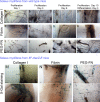Satellite cells delivered in their niche efficiently generate functional myotubes in three-dimensional cell culture
- PMID: 30222770
- PMCID: PMC6141091
- DOI: 10.1371/journal.pone.0202574
Satellite cells delivered in their niche efficiently generate functional myotubes in three-dimensional cell culture
Abstract
Biophysical/biochemical cues from the environment contribute to regulation of the regenerative capacity of resident skeletal muscle stem cells called satellites cells. This can be observed in vitro, where muscle cell behaviour is influenced by the particular culture substrates and whether culture is performed in a 2D or 3D environment, with changes including morphology, nuclear shape and cytoskeletal organization. To create a 3D skeletal muscle model we compared collagen I, Fibrin or PEG-Fibrinogen with different sources of murine and human myogenic cells. To generate tension in the 3D scaffold, biomaterials were polymerised between two flexible silicone posts to mimic tendons. This 3D culture system has multiple advantages including being simple, fast to set up and inexpensive, so providing an accessible tool to investigate myogenesis in a 3D environment. Immortalised human and murine myoblast lines, and primary murine satellite cells showed varying degrees of myogenic differentiation when cultured in these biomaterials, with C2 myoblasts in particular forming large multinucleated myotubes in collagen I or Fibrin. However, murine satellite cells retained in their niche on a muscle fibre and embedded in 3D collagen I or Fibrin gels generated aligned, multinucleated and contractile myotubes.
Conflict of interest statement
IM and TE are co-founders of EHT Technologies GmbH, Hamburg, a UKE spin-off commercializing the materials for the making and analysis of engineered heart tissue. This does not alter our adherence to PLOS ONE policies on sharing data and materials. JP, PSZ and NF declare no competing interests.
Figures





Similar articles
-
Mesenchymal stem cells and myoblast differentiation under HGF and IGF-1 stimulation for 3D skeletal muscle tissue engineering.BMC Cell Biol. 2017 Feb 28;18(1):15. doi: 10.1186/s12860-017-0131-2. BMC Cell Biol. 2017. PMID: 28245809 Free PMC article.
-
Engineering a 3D in vitro model of human skeletal muscle at the single fiber scale.PLoS One. 2020 May 6;15(5):e0232081. doi: 10.1371/journal.pone.0232081. eCollection 2020. PLoS One. 2020. PMID: 32374763 Free PMC article.
-
Label-Free, High-Throughput Purification of Satellite Cells Using Microfluidic Inertial Separation.Tissue Eng Part C Methods. 2018 Jan;24(1):32-41. doi: 10.1089/ten.TEC.2017.0316. Epub 2017 Nov 6. Tissue Eng Part C Methods. 2018. PMID: 28946802 Free PMC article.
-
Are cultured human myotubes far from home?Cell Tissue Res. 2013 Dec;354(3):671-82. doi: 10.1007/s00441-013-1655-1. Epub 2013 Jun 8. Cell Tissue Res. 2013. PMID: 23749200 Review.
-
Cell culture in autologous fibrin scaffolds for applications in tissue engineering.Exp Cell Res. 2014 Mar 10;322(1):1-11. doi: 10.1016/j.yexcr.2013.12.017. Epub 2013 Dec 28. Exp Cell Res. 2014. PMID: 24378385 Review.
Cited by
-
Exogenous Antioxidants in Remyelination and Skeletal Muscle Recovery.Biomedicines. 2022 Oct 13;10(10):2557. doi: 10.3390/biomedicines10102557. Biomedicines. 2022. PMID: 36289819 Free PMC article. Review.
-
Extracellular Heme Proteins Influence Bovine Myosatellite Cell Proliferation and the Color of Cell-Based Meat.Foods. 2019 Oct 21;8(10):521. doi: 10.3390/foods8100521. Foods. 2019. PMID: 31640291 Free PMC article.
-
iPSCs: A powerful tool for skeletal muscle tissue engineering.J Cell Mol Med. 2019 Jun;23(6):3784-3794. doi: 10.1111/jcmm.14292. Epub 2019 Apr 1. J Cell Mol Med. 2019. PMID: 30933431 Free PMC article. Review.
-
The important role of cellular mechanical microenvironment in engineering structured cultivated meat: Recent advances.Curr Res Food Sci. 2024 Sep 21;9:100865. doi: 10.1016/j.crfs.2024.100865. eCollection 2024. Curr Res Food Sci. 2024. PMID: 39416367 Free PMC article. Review.
-
Defining and identifying satellite cell-opathies within muscular dystrophies and myopathies.Exp Cell Res. 2022 Feb 1;411(1):112906. doi: 10.1016/j.yexcr.2021.112906. Epub 2021 Nov 3. Exp Cell Res. 2022. PMID: 34740639 Free PMC article.
References
Publication types
MeSH terms
Substances
Grants and funding
LinkOut - more resources
Full Text Sources
Other Literature Sources
Molecular Biology Databases
Miscellaneous

